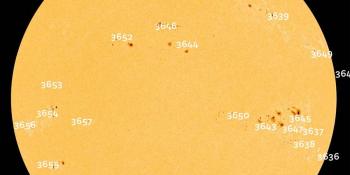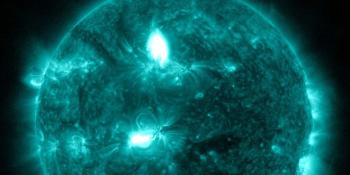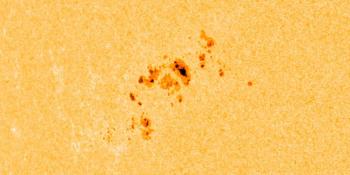Viendo archivo del martes, 23 enero 2001
Informe actividad solar
Any mentioned solar flare in this report has a scaling factor applied by the Space Weather Prediction Center (SWPC). Because of the SWPC scaling factor, solar flares are reported as 42% smaller than for the science quality data. The scaling factor has been removed from our archived solar flare data to reflect the true physical units.
Informe de actividad Solar-Geofísica 2001 Jan 23 2200 UTCPreparado por NOAA © SWPC y procesado por SpaceWeatherLive.com
Informe conjunto USAF/NOAA de actividad Solar y Geofísica
SDF Número 023 Publicado el 2200Z a las 23 Jan 2001IA. Análisis de regiones solares activas y de actividad desde 22-2100Z hasta 23-2100Z Solar activity was low. Region 9311 (N06W62) produced
today's largest flare, a C4/Sf at 2044Z. This group continues to
show slow growth and has a simple beta magnetic configuration.
Region 9313 (S06E01) continues to show some magnetic complexity but
appears to be decaying slowly. Three new sunspot groups were
assigned today: Region 9322 (S23E00), Region 9323 (S29E03) and
Region 9324 (N10E42). All of these groups were small, simple,
bipolar regions.
IB. Pronóstico de la actividad solar
Solar activity is expected to be
mostly low, but there is a chance for an isolated M-class event
during the next three days. Regions 9313 and 9311 are the most
likely sources for enhanced solar activity.
IIA. Resumen de la actividad geofísica 22-2100Z a 23-2100Z
The geomagnetic field was at quiet to active levels during the past
24 hours. The field was initially quiet. However, an interplanetary
shock was observed at the ACE spacecraft at 1008Z and was followed
by a sudden impulse at Earth at 1047Z. Solar wind behind the shock
showed sheath-like characteristics, with Bz oscillating from
negative to positive. Bz did appear to be trending toward more
strongly negative values near forecast issue time (about -10 nT).
The geomagnetic field responded by becoming unsettled to active.
The greater than 10 MeV protons remain enhanced (at about 2 pfu)
but did not increase with the shock passage.
IIB. Pronóstico de la actividad geofísica
The geomagnetic field is
expected to be mostly active during the next 12 to 24 hours, with a
chance for isolated storm periods as the current disturbance
continues. A decrease to unsettled to slightly active levels is
expected for the second and third days.
III. Probabilidades del evento 24 Jan a 26 Jan
| Clase M | 35% | 35% | 35% |
| Clase X | 05% | 05% | 05% |
| Protón | 05% | 05% | 05% |
| PCAF | green | ||
IV. Penticton 10.7cm flujo
Observado 23 Jan 167 Previsto 24 Jan-26 Jan 165/165/160 Media de 90 Días 23 Jan 174
V. Índices Geomagnéticos A
Observado Afr/Ap 22 Jan 008/010 Estimado Afr/Ap 23 Jan 018/015 Previsto Afr/Ap 24 Jan-26 Jan 025/020-012/015-012/015
VI. Probabilidades de Actividad Geomagnética 24 Jan a 26 Jan
| A. Latitudes Medias | |||
|---|---|---|---|
| Activo | 30% | 20% | 20% |
| Tormenta Menor | 25% | 15% | 15% |
| Tormenta Mayor-Severa | 20% | 05% | 05% |
| B. Latitudes Altas | |||
|---|---|---|---|
| Activo | 30% | 35% | 25% |
| Tormenta Menor | 20% | 15% | 15% |
| Tormenta Mayor-Severa | 25% | 10% | 05% |
< < Ir a la visión general diaria
Últimas noticias
Últimos mensajes del foro
AR3654 1IMF - BT strength 5What are these long and thin eruptions? 6AR 3637, 3638, 3643 89Unproven theories 341
Más temasApoye a SpaceWeatherLive.com!
Mucha gente viene a SpaceWeatherLive para seguir la actividad del Sol o previsión de aurora, pero con esta cantidad de tráfico se incrementan los costos del servidor. ¡Considere hacer una donación si disfruta de SpaceWeatherLive para que podamos mantener el sitio web en línea!

Hechos clima espacial
| Último evento clase X | 2024/03/28 | X1.1 |
| Último evento clase M | 2024/04/25 | M1.3 |
| Últimas tormentas geomagnéticas | 2024/04/19 | Kp7 (G3) |
| Días sin manchas | |
|---|---|
| Último día sin manchas | 2022/06/08 |
| Promedio de manchas solares mensuales | |
|---|---|
| marzo 2024 | 104.9 -19.8 |
| Last 30 days | 135.5 +27.6 |


